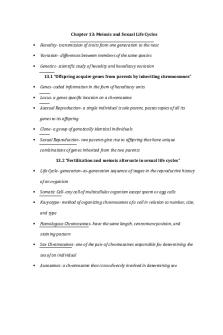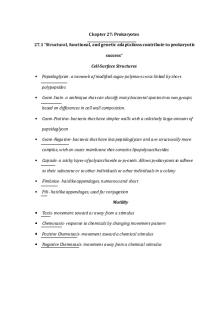Chapter 25 - Summary Campbell Biology PDF

| Title | Chapter 25 - Summary Campbell Biology |
|---|---|
| Author | Nikita Mahay |
| Course | General Biology II |
| Institution | Loyola University Chicago |
| Pages | 6 |
| File Size | 72 KB |
| File Type | |
| Total Downloads | 88 |
| Total Views | 149 |
Summary
notes from lecture and reading ...
Description
Fossils - Show that past organism were different than present day organisms Macroevolution - The broad pattern of evolution above the species level Hypothesis on process that made small cells - The nonliving synthesis of small organic molecules (amino acids and nitrogenous bases_ - The joining of these small molecules into macromolecules (proteins and nucleic acids) - Packing of these molecules into protocells (droplets with membranes that maintain internal chemistry different from that of their surroundings ) - Origin of self- replicating molecules that eventually made inheritance possible Early Earth - 4.6 billion years old - Condensing from vastr clouds of dust and rocks surrounding sun - Collision of rocks → heat → water vaporized → prevented formation of seas and lakes - Water vapor condensed into oceans - Some believe atmosphere was reducing (electron adding ) environment - Some believe it was a neutral environment Hydrothermal vents - An area on the seafloor - Where heated water and minerals from earth's interior gush into sea water - Produces dark, hot, oxygen deficient environment - Producers in hydrothermal vents → chemoautotrophic prokaryotes - Organic compounds formed there → unstable Alkaline Vents - Deep sea hydrothermal vent - Releases warm water (40-90 degrees) - High pH (basic) - Consist of tiny pores lined with iron and other catalytic minerals - Scientist believe those minerals have been the location of the earliest abiotic synthesis of organic compounds Synthesis of RNA - Can occur spontaneously from simple precursor molecules - Polymers formed without the help of enzymes or ribosomes - Amino acid polymers → complex mix of linked and and cross linked amino acids
Protocells - All organisms must carry out reproduction and energy processing (metabolism) - Self replication and metabolic sources → in early protocells - Vesicles → fluid filled compartments enclosed by membrane like structures - Abiotically produced vesicles → exhibit certain properties of life - Form spontaneously when lipids or organic molecules are added to water - Lipid bilayer forms - Can produce on their own (abiotic ) and can grow without dilution of their content Ribozymes - An RNA molecule that functions as an enzyme such as an intron that catalyzes its own removal during RNA splicing First genetic material - RNA - Not DNA RNA - Some had shapes that enable them to replicate faster and with fewer errors - Self replicating RNA - Once RNA sequences that carried genetic info appeared in protocells → changes possible - RNA could provided template on which DNA nucleotides assembled Accurate replication - Advantageous as genomes grew larger Sedimentary Rocks - Richest source of fossils - Strata- rock layers - Fossils shows great changes in kinds of organisms on earth - Many fossils were destroyed Radiometric dating - Determine age of fossil - Based on decay of radioactive “parent” isotope decays to “daughter” isotope at a characteristic rate Half life - Rate of decay - Amount of time it takes for 50% of sample of radioactive isotope to decay - Not affected by temp, pressure, or other environmental variables
Geologic Record - A standard time scale dividing earth’s history into time periods - Grouped into four eons - Hadean - Archaean - Proterozoic - Phanerozoic - Last half billion years - Most of the time that animals have existed - Divided into three groups: Paleozoic, mesozoic ( age of reptiles), cenozoic Stromatolite - Layered rocks that result from the activities of prokaryotes that bind thin films of sediment together - 1.5 billion years Cyanobacteria - Most atmospheric gas → O2 - Free O2 dissolved in surrounding water until elements dissolved in water - iron→ iron oxide - Sediment compressed and left marks in rusting of rocks How did eukaryotes evolve from prokaryotes Endosymbiosis - A relationship bw two species in which one organism lives inside the cell or cell of another organism (host cell) Serial Endosymbiosis - A hypothesis for the origin of eukaryotes consisting of a sequences of endosymbiotic events in which mitochondria, chloroplasts, and perhaps other cellular structures were derived from small prokaryotes that had been engulfed by larger cells - Host gives rise to mitochondria- thought to have been an archean or closely related
Facts supporting endosymbiotic origin of mitochondria and plastid
-
-
Inner membrane of both organelles have enzymes and transport systems that are homologous to those found in a plasma membrane of living bacteria Mitochondria and plastid replicate by splitting process that is similar to that of certain bacteria - Contains circular DNA molecules that are not associated with histones or large amounts of proteins Organelles descended from free living organisms, mitochondria and plastids also have the cellular machinery needed to transcribe and translate their DNA into proteins RNA sequences→ ribosomes of mitochondria and plastid are more similar to bacterial ribosomes than they are to the cytoplasmic ribosomes of eukaryotic cells
Early multicellular eukaryotes - Small red algae - Rise to large multicellular eukaryotes = enormous change in history Cambrian Explosion - Many present day phyla of animals first appeared in fossil record - 535-525 million years ago - Emergence of first large, hard bodied animals - Before explosion→ all large animals were soft bodied Colonization of land - Cyanobacteria and prokaryote coated damp terrestrial surfaces - Adaptations allowed for animals to reproduce on land - Arthropods and tetrapods
Plate tectonics - Theory that continents are part of great plates of earths crust that float on the hot, underlying portion of the mantle - Movements in the mantle cause continents to move slowly over time (continental drift) - Earthquakes → when two plates slide past eachother - Climate change - Allopatric speciation - Distribution of extinct organisms Continental drift - Rearranged geography slowly - Alters habitats in which organisms live
Pangea
-
Subcontinent that formed near the end of the paleozoic area When plate movements brought all the landmasses of earth together
Mass extinction - The elimination of a large number of species throughout earth - Result of global environmental changes - 5 mass extinctions occured - Permian and cretaceous → most attention Permian - Mass extinction - 96% marine animals species and drastically altered life in the ocean - Episode of volcanism - Rise in CO2 levels → ocean acidification Cretaceous - Half of all marine species - Eliminated many families of terrestrial plants and animals Consequences of mass extinctions - Long term effects - Can reduce complex ecological community - Adaptive radiation Adaptive Radiation - Period of evolutionary change in which groups of organisms form many new species whose adaptations allow them to fill different ecological roles in their communities - Increased diversity of life - Organisms can serve as a new source of food for other organisms - Can be initiated when organisms make their way toa new, distant location
Heterochrony - Evolutionary change in the timing or rate of an organism’s development - Can alter adult form - Increase growth rates of finger bones - Slow growth of leg and pelvic growth - Can alter timing of reproductive development relative to development of non reproductive organs Paedomorphosis - The retention in an adult organism of the juvenile features of its evolutionary ancestors - Can produce animals that appear very different from their ancestors Homeotic Genes - Any of the master regulatory genes that control placement and spatial organization of
Eyes -
body parts in animals, plants, and fungi Controlling development fate of groups of cells Cells develop into structure appropriate for particular location
Evolved over time proof ? → some animal eyes are less complex than human eyes Limpets in eyes
Trends - Trend towards larger or smaller body size -...
Similar Free PDFs

Ch26 - Summary Campbell Biology
- 6 Pages
Popular Institutions
- Tinajero National High School - Annex
- Politeknik Caltex Riau
- Yokohama City University
- SGT University
- University of Al-Qadisiyah
- Divine Word College of Vigan
- Techniek College Rotterdam
- Universidade de Santiago
- Universiti Teknologi MARA Cawangan Johor Kampus Pasir Gudang
- Poltekkes Kemenkes Yogyakarta
- Baguio City National High School
- Colegio san marcos
- preparatoria uno
- Centro de Bachillerato Tecnológico Industrial y de Servicios No. 107
- Dalian Maritime University
- Quang Trung Secondary School
- Colegio Tecnológico en Informática
- Corporación Regional de Educación Superior
- Grupo CEDVA
- Dar Al Uloom University
- Centro de Estudios Preuniversitarios de la Universidad Nacional de Ingeniería
- 上智大学
- Aakash International School, Nuna Majara
- San Felipe Neri Catholic School
- Kang Chiao International School - New Taipei City
- Misamis Occidental National High School
- Institución Educativa Escuela Normal Juan Ladrilleros
- Kolehiyo ng Pantukan
- Batanes State College
- Instituto Continental
- Sekolah Menengah Kejuruan Kesehatan Kaltara (Tarakan)
- Colegio de La Inmaculada Concepcion - Cebu














